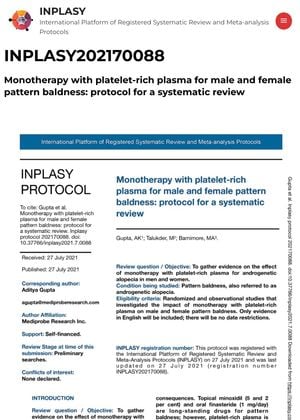Monotherapy with Platelet-Rich Plasma for Male and Female Pattern Baldness: Protocol for a Systematic Review
July 2021

TLDR The document is about planning a review to assess if PRP alone is effective for treating hair loss in men and women.
This document outlines the protocol for a systematic review that aims to evaluate the effectiveness of platelet-rich plasma (PRP) as a standalone treatment for male and female pattern baldness. The review will include randomized controlled trials (RCTs) that have used PRP as a monotherapy for this condition. The primary outcome will be the change in hair density, while secondary outcomes will include changes in hair thickness, patient satisfaction, and adverse events. The review will follow the PRISMA guidelines for systematic reviews and meta-analyses. The results of this review will provide evidence-based recommendations for the use of PRP in treating pattern baldness.






